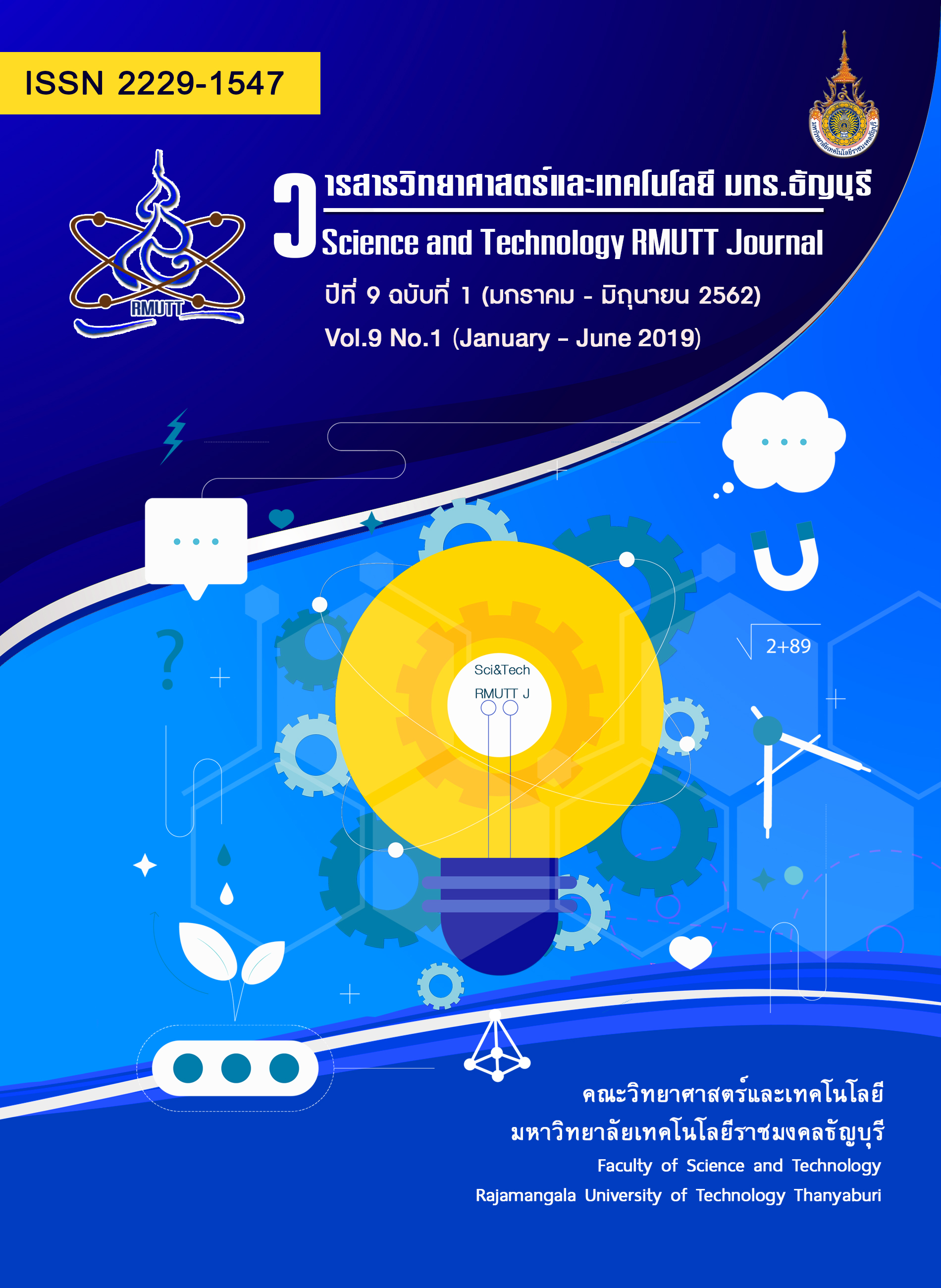Pigment and Nutritional Value of Spirogyra spp. in Sakon Nakhon, Nakhon Phanom and Mukdahan Provinces
Main Article Content
Abstract
Edible freshwater macroalgae, Spirogyra spp. (Division Chlorophyta) are normally found in natural water sources and local markets, and are commonly consumed as a traditional type of food in north-eastern Thailand. Spirogyra spp. has been found to possess high nutritional value and contain various bioactive compounds. The focus of this research study was to examine the pigments and to assess the nutritional value of the Spirogyra spp. samples collected from 12 water resources of Sakon Nakhon, Nakhon Phanom and Mukdahan Provinces. The samples collected from each sampling site were dried and the pigment quantity and nutritional value were analyzed. The highest quantity of chlorophyll a, b and the carotenoid content were recorded at 4.067, 1.716 and 1.209 mg/g of cell dry weight, respectively. The samples were tested for their basic nutritional value and the highest values of ash, fat, moisture, protein, carbohydrate and energy were recorded at 17.37, 5.51, 14.90, 22.77, 67.13 g/100g and 363 kcal/100g, respectively. Thus, the results of this study support the possibility of using Spirogyra spp. as a food supplement and antioxidant products.
Article Details
References
Bellinger E.G and Sigee D.C. Freshwater Algae: Identification and Use as Bioindicators. John Wiley & Sons, Ltd., West Sussex. 2010.
Peerapornpisal Y. Freshwater Algae in Thailand. 3rd ed. Department of Biology, Faculty of Science, Chiang Mai University, Chiang Mai. 2013.
Kim S.K. Handbook of Marine Microalgae Biotechnology Advances. Academic press, Amsterdam. 2015.
Peerapornpisal, Y. Phycology. Department of Biology, Faculty of Science, Chiang Mai University, Chiang Mai. 2006.
Peerapornpisal Y., Pongsirikul I. and Kanjanapothi D. Potential of Freshwater Macroalgae as Food and Medicine. Final report submitted to Thailand Research Fund (TRF). 2005.
Carlsson A.S., van Beilan J.B., Moller R. and Clayton D. Micro and Macro Algae: Utility for Industrial Applications. Cpl press, Newbury. 2007.
Phinyo K. Potentials of polysachcharides from Tao [Spirogyra neglecta (Hassall) Kützing] for use as prebiotic. Ph.D. Thesis. Department of Biology. Chiang Mai University. 2012.
Naik Ansari A., Hemavani C. and Thippeswamy B. Evaluation of antimicrobial property of Spirogyra species. International Multidisciplinary Research Journal. 2012. 2(2) : 13-15.
Kamble S.M., Rokde A.U. and Chavan A.M. Antifungal activity of algal extracts against plant pathogenic fungi. International Multidisciplinary Research Journal. 2012. 2(3) : 23-24.
Snehalatha D. and Digamber Rao B. Antifungal activity of freshwater green-algae (Chlorophyceae). European Journal of Pharmaceutical and Medical Research. 2015. 2(5) : 1394-1402.
Duangjai A., Limpeanchob N., Trisat K. and Amornlerdpison D. Spirogyra neglecta inhibits the absorption and synthesis of cholesterol in vitro. Integrative Medicine Research. 2016. 301-308.
Amornlerdpison D., Duangjan K., Kanjanapothi D., Taesotikul T. and Peerapornpisal Y. Gastroprotective activity of Spirogyra neglecta (Hassall) Kützing. KKU Sci. J. 2012. 40(1) : 236-241.
Surayot U., Wang J.G., Lee J.H., Kanongnuch C., Peerapornpisal Y. and You S.G. Characterization and immunomodulatory activities of polysachcharides from Spirogyra neglecta (Hassall) Kützing. Bioscience, Biotechnology and Biochemistry. 2015. 79(10) : 1644-1653.
Thumvijit T., Inboot W., Peerapornpisal Y., Amornlerdpison D. and Wongpoomchai R. The antimutagenic and antioxidant properties of Spirogyra neglecta (Hassall) Kützing. Journal of Medicinal Plants Research. 2013. 7(34) : 2494-2500.
Pal R. and Choudhury A.K. An Introduction to Phytoplanktons: Diversity and Ecology. Springer, India. 2014.
Palace V.P., Khaper N., Qin Q. and Singal P.K. Antioxidant potentials of vitamin A and carotenoids and their relevance to heart disease. Free Radic Biol Med. 1999. 26(5-6) : 746-761.
Tipnee S. Ramaraj R. and Unpaprom Y. Nutrional evaluation of edible freshwater green macroalgae Spirogyra varians. Emer Life Sci Res. 2015. 1(2) : 1-7.
John D.M., Whitton B.A. and Brook A.J. The Freshwater Algal Flora of the British Isles: an identification guide to freshwater and terrestrial algae. 2nd ed. Cambridge University Press, Cambridge. 2011.
Punyoyai T. Antioxidant activity of Tao, Spirogyra neglecta (Hassall) Kützing. M.Sc. Thesis. Department of Biology, Chiang Mai University. 2008.
AOAC. Official Method of Analysis. The Association of Official Analytical Chemist. 20th ed. Gaithersburg, Maryland. 2016.
National Bureau of Agricultural Commodity and Food Standards. Compendium of Method for Food Analysis. Ministry of Agriculture and Cooperatives, Bangkok. 2003.
Kanajan K. and Chueduengqi K. Investigation of macroalgae in Kham Hom Waterfall, Amphoe Mueang Sakon Nakhon, Sakon Nakhon Province in 2015-2016. Research Project in Biology. Faculty of Science, Sakon Nakhon Rajabhat University. 2017.
Moonsin P. Diversity of Macroalgae and some Water Quality Parameters in Huay Tham Khae Reservoir, Trakan Phuet Phon District, Ubon Ratchathani Province. KMUTT Research and Development Journal. 2016. 30(1) : 37-50.
Thamprawat J. and Srikanchai N. Extraction of chlorophylls and carotenoid from Spirogyra spp. Research Project in Biology. Faculty of Science, Sakon Nakhon Rajabhat University. 2017.
Ministry of Public Health. Nutritive Values of Thai Foods. Department of Health, Ministry of Public Health, Bangkok. 2001.






